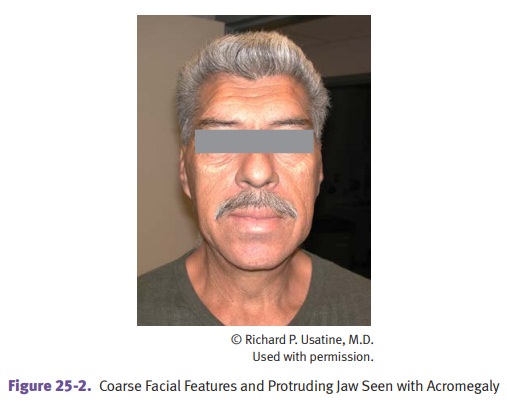Chapter: Pathology: Endocrine Pathology
Pituitary Gland, Hypothalamus, and Pineal Gland - Pathology
PITUITARY GLAND, HYPOTHALAMUS, AND PINEAL GLAND
Pituitary adenomas are categorized as follows:
•
Microadenoma
if <1 cm
•
Macroadenoma
if >1 cm
Macroadenomas cause visual
field defects.
GNAS1 mutations are common. Pathologically, adenomas are monomorphic
com-pared with normal pituitary.

•
Prolactinoma
is the
most common type of pituitary adenoma. Lactotroph cells secrete prolactin, which results in
hyperprolactinemia. Clinical features include galactorrhea, amenorrhea, and
infertility, or decreased libido and impotence.
•
Nonfunctional
adenoma may produce hypopituitarism.
•
Growth-hormone–producing
adenoma is characterized by elevated growth hormone (GH) and elevated
somatomedin C (insulin-like growth factor 1 [IGF-1]). It causes gigantism in
children and acromegaly in adults.

Sheehan syndrome is ischemic necrosis of the
pituitary secondary to hypotension from postpartum hemorrhage
resulting in panhypopituitarism.
Posterior pituitary syndromes include the following:
•
Diabetes
insipidus
°°
Central diabetes insipidus is caused by ADH deficiency, which
results in hypotonic polyuria, polydipsia, hypernatremia, and dehydration.
Causes include head trauma and tumors.
°°
Nephrogenic diabetes insipidus is caused by a lack of renal
response to ADH.
•
Syndrome
of inappropriate ADH secretion (SIADH) is caused by excessive pro-duction of
antidiuretic hormone (ADH), resulting in oliguria, water retention,
hyponatremia, and cerebral edema. Causes include paraneoplastic syndrome and
head trauma.
Craniopharyngioma is a benign pituitary tumor
derived from Rathke pouch rem-nants that is usually located above the sella
turcica, but can extend downward to destroy the pituitary. It is the most
common cause of hypopituitarism in children.
Hypothalamic disorders can cause a variety of
problems:
•
Hypopituitarism
(including
dwarfism) can be due to a lack of releasing hor-mones from the hypothalamus.
•
Central
diabetes insipidus is due to lack of ADH synthesis.
•
Precocious
puberty is usually due to a midline hamartoma in boys.
•
The hypothalamus can also be affected in hydrocephalus.
•
Visual
field changes can complicate hypothalmic disorders.
•
Masses can affect the hypothalamus, i.e., pituitary adenoma,
craniopharyn-gioma, midline hamartoma, and Langerhans histiocytosis.
•
Inflammatory processes can affect the hypothalamus, i.e.,
sarcoidosis and meningitis.
Pineal diseases include dystrophic
calcification (a useful landmark for radiologists) and rarely tumors, with most
being germ cell tumors.
Related Topics